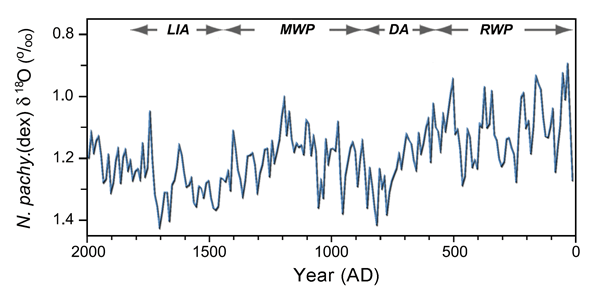Reference
Sejrup, H.P., Haflidason, H. and Andrews, J.T. 2011. A Holocene North Atlantic SST record and regional climate variability. Quaternary Science Reviews 30: 3181-3195.
Description
By means of the combined use of 210Pb dates, identification of Icelandic tephras of known age, and wiggle matching of 14C radiocarbon dates, Sejrup et al. established exceptionally accurate chronologies for two marine sediment cores raised from the same location on the Norwegian continental margin (63°45'44"N, 05°15'19"E) in 1998, after which they evaluated δ18O values of the planktonic foram Neogloboquadrina pachyderma (dex) -- which parameter is influenced by the temperature and salinity of the seawater in which the foram lives -- over the 8000-year period spanned by the retrieved cores. Then, after noting that the work of Berstad et al. (Journal of Quaternary Science 18: 591-602) suggests that salinity should have but a relatively small influence on the isotope values of N. Pachy. (dex) at the site of their study, they developed the δ18O history depicted in the figure below, which they use as a proxy for what they call "near surface water summer temperature." And as this history clearly shows, the peak warmth of the Medieval Warm Period was significantly greater than the peak warmth of the Current Warm Period has been to date.

Fig. 1. N. pachyderma (dex) δ18O vs. time. Adapted from Sejrup et al. (2011).




